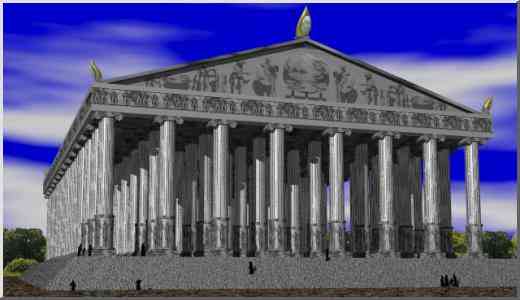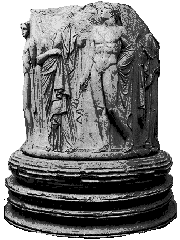The Temple of Artemis

1100 A.D.: A troop of Crusaders stops
at a muddy little village in Asia Minor. Their leader looks around.
Confused ,he dismounts. This place is not what he expected. He read in the
ancient texts that this was a large seaport with many ships docked in its
bay. It isn't. The sea is almost three miles away. The village is located
in a swamp. There are no ships to be seen. The leader accosts a nearby
man.
"Sir, is this the city of Ephesus?"
"It was called that once. Now it is
named Ayasalouk."
"Well, where is your bay? Where are
the trading ships? And where is the magnificent Greek temple that we have
heard about?"
Now it is the man's turn to be
confused. "Temple? What temple, Sir? We have no temple here..."
And so 800 years after its destruction, the magnificent
Temple of Artemis at Ephesus, one of the Seven Wonders of the Ancient
World, had been completely forgotten by the people of the town that had
once held it in such pride.
And there is no doubt that the temple
was indeed magnificent. "I have seen the walls and Hanging Gardens of
ancient Babylon," wrote Philon of Byzantium, "the statue of Olympian Zeus,
the Colossus of Rhodes, the mighty work of the high Pyramids and the tomb
of Mausolus. But when I saw the temple at Ephesus rising to the clouds,
all these other wonders were put in the shade."
So what happened to this great temple?
And what happened to the city that hosted it? What turned Ephesus from a
busy port of trade to a few shacks in a swamp?
The first shrine to the Goddess Artemis
was probably built around 800 B.C. on a marshy strip near the river at
Ephesus. The Ephesus Goddess Artemis, sometimes called Diana, is not the
same figure as the Artemis worshiped in Greece. The Greek Artemis is the
goddess of the hunt. The Ephesus Artemis was a goddess of fertility and
was often pictured as draped with eggs, or multiple breasts, symbols of
fertility, from her waist to her shoulders.
That earliest temple contained a sacred
stone, probably a meteorite, that had "fallen from Jupiter." The shrine
was destroyed and rebuilt several times over the next few hundred years.
By 600 B.C., the city of Ephesus had become a major port of trade and an
architect named Chersiphron was engaged to build a new large temple. He
designed it with high stone columns. Concerned that carts carrying the
columns might get mired in the swampy ground around the site, Chersiphron
laid the columns on their sides and had them rolled to where they would be
erected.
This temple didn't last long. In 550
B.C. King Croesus of Lydia conquered Ephesus and the other Greek cities of
Asia Minor. During the fighting, the temple was destroyed. Croesus proved
himself a gracious winner, though, by contributing generously to the
building of a new temple.
This was next to the last of the great
temples to Artemis in Ephesus and it dwarfed those that had come before.
The architect is thought to be a man named Theodorus. Theodorus's temple
was 300 feet in length and 150 feet wide with an area four times the size
of the temple before it. More than one hundred stone columns supported a
massive roof. The new temple was the pride of Ephesus until 356 B.C. when
a tragedy, by name of Herostratus, struck.
Herostratus was a young Ephesian who
would stop at no cost to have his name go down in history. He managed this
by burning the temple to the ground. The citizens of Ephesus were so
appalled at this act they issued a decree that anyone who spoke of
Herostratus would be put to death.
Shortly after this horrible deed, a new
temple was commissioned. The architect was Scopas of Paros, one of the
most famous sculptors of his day. Ephesus was one of the greatest cities
in Asia Minor at this point and no expense was spared in the construction.
According to Pliny the Elder, a Roman historian, the temple was a
"wonderful monument of Grecian magnificence, and one that merits our
genuine admiration."
The temple was built in the same marshy
place as before. To prepare the ground, Pliny recorded that "layers of
trodden charcoal were placed beneath, with fleeces covered with wool upon
the top of them."

The building is thought to be the first
completely constructed with marble and one of its must unusual features
were 36 columns whose lower portions were carved with figures in
high-relief (left). The temple also housed many works of art
including four bronze statues of Amazon women.
Pliny recorded the length of this new
temple at 425 feet and the width at 225 feet. Some 127 columns, 60 feet in
height, supported the roof. In comparison the Parthenon, the remains of
which stand on the acropolis in Athens today, was only 230 feet long, 100
feet wide and had 58 columns.
According to Pliny, construction took
120 years, though some experts suspect it may have only taken half that
time. We do know that when Alexander the Great came to Ephesus in 333
B.C., the temple was still under construction. He offered to finance the
completion of the temple if the city would credit him as the builder. The
city fathers didn't want Alexander's name carved on the temple, but didn't
want to tell him that. They finally gave the tactful response: "It is not
fitting that one god should build a temple for another god" and Alexander
didn't press the matter.
Pliny reported that earthen ramps were
employed to get the heavy stone beams perched on top of the columns. This
method seemed to work well until one of the largest beams was put into
position above the door. It went down crookedly and the architect could
find no way to get it to lie flat. He was beside himself with worry about
this until he had a dream one night in which the Goddess herself appeared
to him saying that he should not be concerned. She herself had moved the
stone in the proper position. The next morning the architect found that
the dream was true. During the night the beam had settled into its proper
place.
The city continued to prosper over the
next few hundred years and was the destination for many pilgrims coming to
view the temple. A souvenir business in miniature Artemis idols, perhaps
similar to a statue of her in the temple, grew up around the shrine. It
was one of these business proprietors, a man named Demetrius, that gave
St. Paul a difficult time when he visited the city in 57 A.D.
St. Paul came to the city to win
converts to the then new religion of Christianity. He was so successful
that Demetrius feared the people would turn away from Artemis and he would
lose his livelihood. He called others of his trade together with him and
gave a rousing speech ending with "Great is Artemis of the Ephesians!"
They then seized two of Paul's companions and a near riot followed.
Eventually the city was quieted, the men released, and Paul left for
Macedonia.
It was Paul's Christianity that won out
in the end, though. By the time the great Temple of Artemis was destroyed
during a raid by the Goths in 262 A.D., both the city and the religion of
Artemis were in decline. When the Roman Emperor Constantine rebuilt much
of Ephesus a century later, he declined to restore the temple. He had
become a Christian and had little interest in pagan temples.
Despite Constantine's efforts, Ephesus
declined in its importance as a crossroads of trade. The bay where ships
docked disappeared as silt from the river filled it. In the end what was
left of the city was miles from the sea, and many of the inhabitants left
swampy lowland to live in the surrounding hills. Those that remained used
the ruins of the temple as a source of building materials. Many of the
fine sculptures were pounded into powder to make lime for wall plaster.
In 1863 the British Museum sent John
Turtle Wood, an architect, to search for the temple. Wood met with
many obstacles. The region was infested with bandits. Workers were hard to
find. His budget was too small. Perhaps the biggest difficulty was that he
had no idea where the temple was located. He searched for the temple for
six years. Each year the British Museum threatened to cut off his funding
unless he found something significant, and each year he convinced them to
fund him for just one more season.
Wood kept returning to the site each
year many despite hardships. During his first season he was thrown from a
horse, breaking his collar bone. Two years later he was stabbed within an
inch of his heart during an assassination attempt upon the British Consul
in Smyrna.
Finally in 1869, at the bottom of a
muddy twenty-foot deep test pit, his crew struck the base of the great
temple. Wood then excavated the whole foundation removing 132,000 cubic
yards of the swamp to leave a hole some 300 feet wide and 500 feet long.
The remains of some of the sculptured portions were found and shipped the
to British Museum where they can be viewed even today.
In 1904 another British Museum
expedition under the leadership of D.G. Hograth continued the
excavation. Hograth found evidence of five temples on the site, each
constructed on top of the other.
Today the site of the temple is a marshy
field. A single column is erect to remind visitors that once there stood
in that place one of the wonders of the ancient world.
Top of page

|